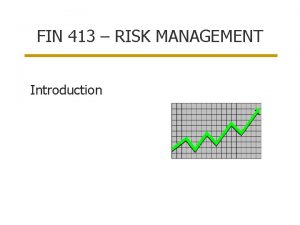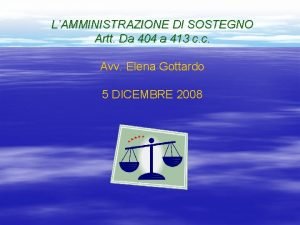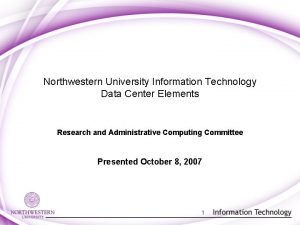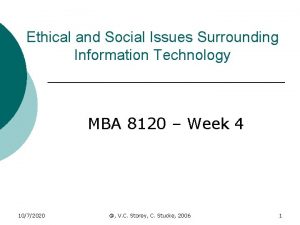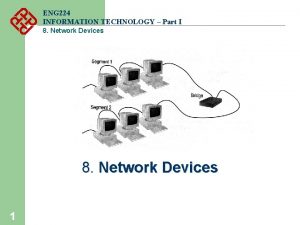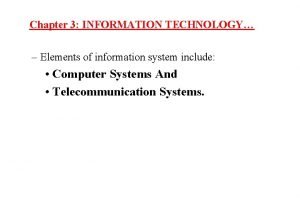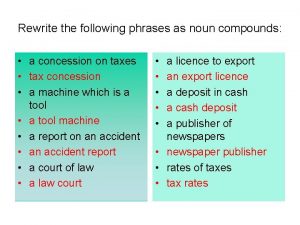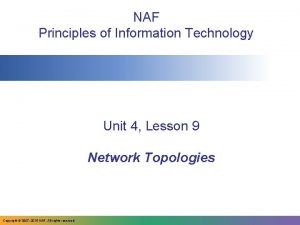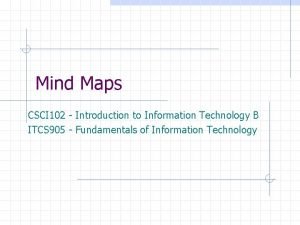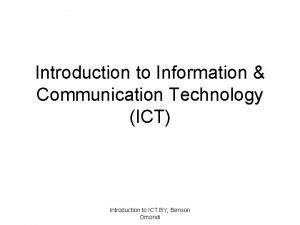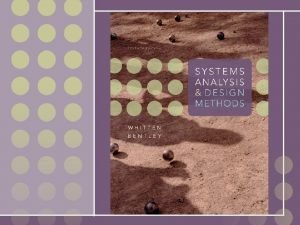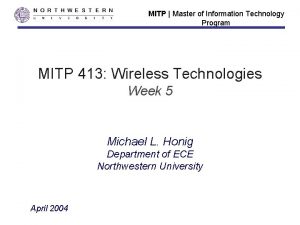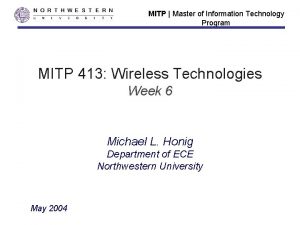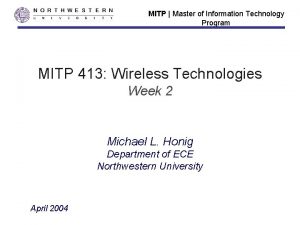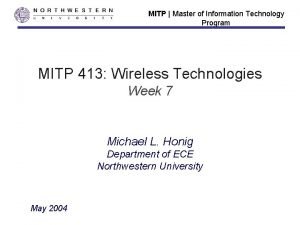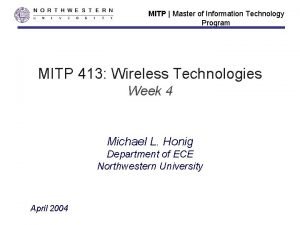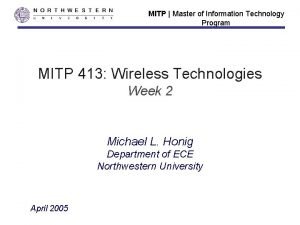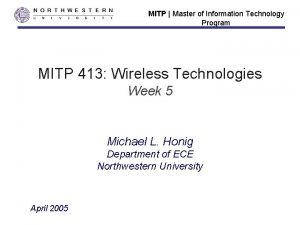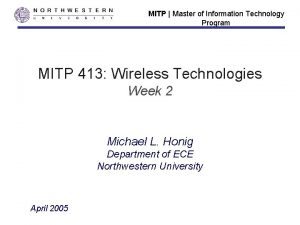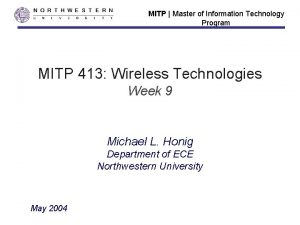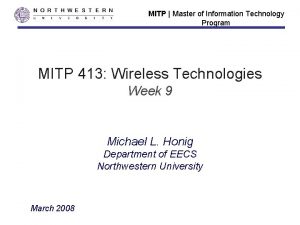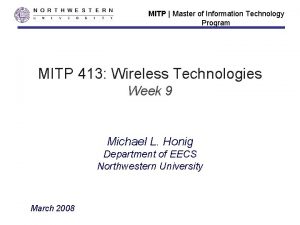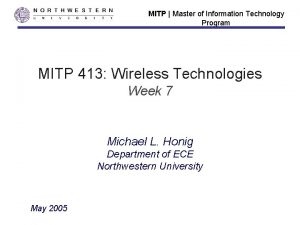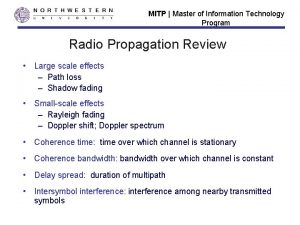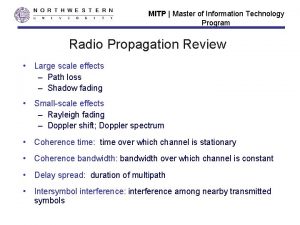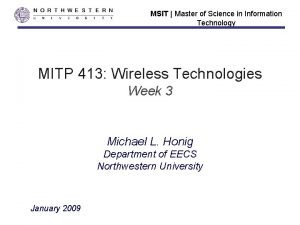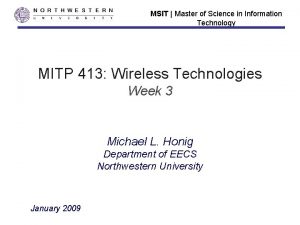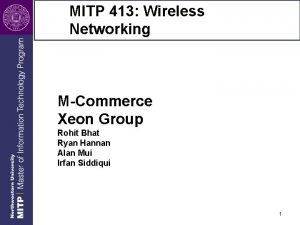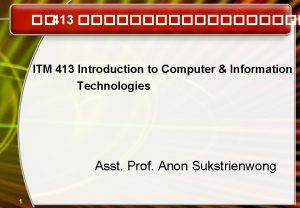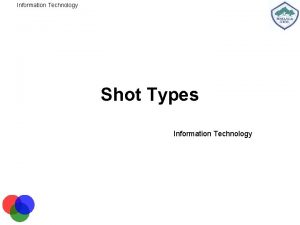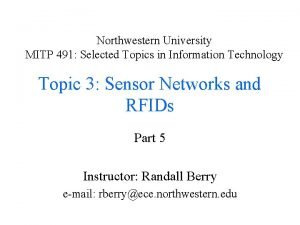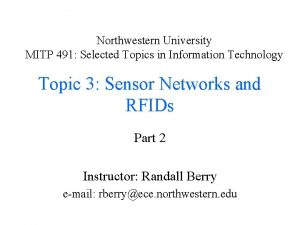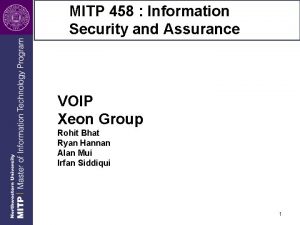MITP Master of Information Technology Program MITP 413











































































- Slides: 75

MITP | Master of Information Technology Program MITP 413: Wireless Technologies Week 3 Michael L. Honig Department of ECE Northwestern University January 2007

MITP | Master of Information Technology Program Why Study Radio Propagation? • To determine coverage Can we use the same channels? • Must determine path loss – Function of • Frequency • Distance • Terrain (office building, urban, hilly, rural, etc. ) Need “large-scale” models

MITP | Master of Information Technology Program Why Study Radio Propagation? • To enable robust communications (MODEM design) Received Power Deep fades may cause an outage time • • • How can we guarantee reliable communications? What data rate can we provide? Must determine signal statistics: – Probability of outage – Duration of outage Need “small-scale” models

MITP | Master of Information Technology Program Propagation Key Words • Large-scale effects – Path-loss exponent – Shadow fading • Small-scale effects – Rayleigh fading – Doppler shift and Doppler spectrum – Coherence time / fast vs slow fading • Narrowband vs wideband signals • Multipath delay spread and coherence bandwidth • Frequency-selective fading and frequency diversity

MITP | Master of Information Technology Program Propagation Mechanisms: 1. Free Space distance d reference distance d 0=1 Reference power at reference distance d 0 P 0 In d. B: Pr = P 0 (d. B) – 20 log (d) slope = -20 d. B per decade Pr (d. B) P 0 = Gt Gr ( /4 )2 antenna gains wavelength Path loss exponent=2 log (d) 0

MITP | Master of Information Technology Program Wavelength (meters) = c (speed of light) / frequency • Wavelength >> size of object signal penetrates object. • Wavelength << size of object signal is absorbed and/or reflected by object. • Large-scale effects refers to propagation over distances of many wavelengths. Small-scale effects refers to propagation over a distances of a fraction of a wavelength.

MITP | Master of Information Technology Program Attenuation: Wireless vs. Wired Unshielded Twisted Pair • Path loss ~ 13 d. B / 100 meters or 130 d. B / 1 km – Increases linearly with distance • Requires repeaters for long distances 1 GHz Radio (free space) • Path loss ~ 30 d. B for the first meter + 20 d. B / decade – 70 d. B / 100 meters (2 decades) – 90 d. B / 1 km (3 decades) – 130 d. B / 100 km! – Increases as log (distance) • Repeaters are infeasible for satellites Short distance Wired has less path loss. Large distance Wireless has less path loss.

MITP | Master of Information Technology Program Propagation Mechanisms 2. Reflection Incident E-M wave Length of boundary >> wavelength transmitted wave 3. Diffraction Signal loss depends on geometry Hill 4. Scattering reflected wave

MITP | Master of Information Technology Program Why Use > 500 MHz?

MITP | Master of Information Technology Program Why Use > 500 MHz? • There is more spectrum available above 500 MHz. • Lower frequencies require larger antennas – Antenna dimension is on the order of a wavelength = (speed of light/frequency) = 0. 6 M @ 500 MHz • Path loss increases with frequency for the first meter – 10’s of GHz: signals are confined locally – More than 60 GHz: attenuation is too large (oxygen absorbs signal)

MITP | Master of Information Technology Program Radio Channels Troposcatter Microwave LOS T T Mobile radio Indoor radio

MITP | Master of Information Technology Program Sinusoidal Signal Electromagnetic wave s(t) = A sin (2 f t + ) Time delay = 12, Phase shift = 12/50 cycle = 86. 4 degrees s(t) Amplitude A=1 Period= 50 sec, frequency f = 1/50 cycle/sec Time t (seconds)

MITP | Master of Information Technology Program Two Signal Paths s 1(t) s 2(t) Received signal r(t) = s 1(t) + s 2(t) Suppose s 1(t) = sin 2 f t. Then s 2(t) = h s 1(t - ) = h sin 2 f (t - ) attenuation (e. g. , h could be ½) delay (e. g. , could be 1 microsec. )

MITP | Master of Information Technology Program Sinusoid Addition (Constructive) s 1(t) r(t) + s 2(t) =

MITP | Master of Information Technology Program Sinusoid Addition (Destructive) s 1(t) r(t) s 2(t) + = Signal is faded.

MITP | Master of Information Technology Program Indoor Propagation Measurements Ceiling Hypothetical large indoor environment Normalized received power vs. distance

MITP | Master of Information Technology Program Power Attenuation distance d reference distance d 0=1 Reference power at reference distance d 0 P 0 In d. B: Pr = P 0 (d. B) – 10 n log (d) Path loss exponent slope (n=2) = -20 d. B per decade Pr (d. B) slope = -40 (n=4) 0 log (d)

MITP | Master of Information Technology Program Path Loss Exponents ENVIRONMENT Free space Urban cellular radio Shadowed urban cellular radio PATH LOSS EXPONENT, n 2 2. 7 to 3. 5 3 to 5 In building line-of-site 1. 6 to 1. 8 Obstructed in building 4 to 6 Obstructed in factories 2 to 3

MITP | Master of Information Technology Program Large-Scale Path Loss Average Received Power (d. Bm) (Scatter Plot) Distance (meters)

MITP | Master of Information Technology Program Shadow Fading • Random variations in path loss as mobile moves around buildings, trees, etc. • Modeled as an additional random variable: Pr = P 0 – 10 n log d + X “normal” (Gaussian) probability distribution standard deviation - For cellular: is about 8 d. B “log-normal” random variable received power in d. B

MITP | Master of Information Technology Program Large-Scale Path Loss (Scatter Plot)

MITP | Master of Information Technology Program Empirical Path Loss Models • Propagation studies must take into account: – – Environment (rural, suburban, urban) Building characteristics (high-rise, houses, shopping malls) Vegetation density Terrain (mountainous, hilly, flat) • Okumura’s model (based on measurements in and around Tokyo) – Median path loss = free-space loss + urban loss + antenna gains + corrections – Obtained from graphs – Additional corrections for street orientation, irregular terrain • Numerous indoor propagation studies for 802. 11

MITP | Master of Information Technology Program SINR Measurements: 1 x. EV-DO drive test plots

MITP | Master of Information Technology Program Link Budget How much power is required to achieve target S/I? • d. Bs add: Target S/I (d. B) + path loss (d. B) + other losses (components) (d. B) - antenna gains (d. B) Total Power needed at transmitter (d. B) • Actual power depends on noise level. – Given 1 microwatt noise power, if the transmit power is 60 d. B above the noise level then the transmit power is 1 Watt.

MITP | Master of Information Technology Program Urban Multipath • No direct Line of Sight between mobile and base • Radio wave scatters off of buildings, cars, etc. • Severe multipath

MITP | Master of Information Technology Program Narrowband vs. Wideband • Narrowband means that the bandwidth of the transmitted signal is small (e. g. , < 100 k. Hz for cellular). It therefore looks “almost” like a sinusoid. – Multipath changes the amplitude and phase. • Wideband means that the transmitted signal has a large bandwidth (e. g. , > 1 MHz for cellular). – Multipath causes “self-interference”.

MITP | Master of Information Technology Program Narrowband Fading Received signal r(t) = h 1 s(t - 1 ) + h 2 s(t - 2) + h 3 s(t - 3 ) + … attenuation for path 1 (random) delay for path 1 (random) If the transmitted signal is sinusoidal (narrowband), s(t) = sin 2 f t, then the received signal is also sinusoidal, but with a different (random) amplitude and (random) phase: r(t) = A sin (2 f t + ) Transmitted s(t) Received r(t) A, depend on environment, location of transmitter/receiver

MITP | Master of Information Technology Program Rayleigh Fading Can show: A has a “Rayleigh” distribution has a “uniform” distribution (all phase shifts are equally likely) 2 Probability (A < a) = 1 – e-a /P 0 where P 0 is the average received power (averaged over different locations) Prob(A < a) 1 2/P 0 1 -e-a a Ex: P 0 =1, a=1: Pr(A<1) = 1 – e-1 = 0. 63 P 0 = 1, a=0. 1: Pr(A<0. 1) = 1 – e-1/100 ≈ 0. 01

MITP | Master of Information Technology Program Small-Scale Fading

MITP | Master of Information Technology Program Small-Scale Fading Fade rate depends on • Mobile speed • Speed of surrounding objects • Frequency

MITP | Master of Information Technology Program Short- vs. Long-Term Fading Signal Strength (d. B) Short-term fading Long-term fading T T Time (t) Long-term (large-scale) fading: • Distance attenuation • Shadowing (blocked Line of Sight (LOS)) • Variations of signal strength over distances on the order of a wavelength

MITP | Master of Information Technology Program Combined Fading and Attenuation Received power Pr (d. B) distance attenuation Time (mobile is moving away from base)

MITP | Master of Information Technology Program Combined Fading and Attenuation Received power Pr (d. B) distance attenuation shadowing Time (mobile is moving away from base)

MITP | Master of Information Technology Program Combined Fading and Attenuation Received power Pr (d. B) distance attenuation shadowing Rayleigh fading Time (mobile is moving away from base)

MITP | Master of Information Technology Program Example Diagnostic Measurements: 1 XEV-DO drive test measurements drive path

MITP | Master of Information Technology Program Time Variations: Doppler Shift velocity v distance d = v t Propagation delay = distance d / speed of light c = vt/c transmitted signal s(t) received signal r(t) propagation delay Received signal r(t) = sin 2 f (t- vt/c) = sin 2 (f – fv/c) t received frequency Doppler shift fd = -fv/c

MITP | Master of Information Technology Program Doppler Shift (Ex) Mobile moving away from base v > 0, Doppler shift < 0 Mobile moving towards base v < 0, Doppler shift > 0 Carrier frequency f = 900 MHz, v = 60 miles/hour = 26. 82 meters/sec Mobile Base: fd = fv/c = (900 × 106) × 26. 82 / (3 × 108) ≈ 80 Hz meters/sec

MITP | Master of Information Technology Program Doppler (Frequency) Shift ½ Doppler “cycle” in phase Frequency= 1/50 out of phase Frequency= 1/45

MITP | Master of Information Technology Program Doppler Shift (Ex) Mobile moving away from base v > 0, Doppler shift < 0 Mobile moving towards base v < 0, Doppler shift > 0 Carrier frequency f = 900 MHz, v = 60 miles/hour = 26. 82 meters/sec Mobile Base: fd = fv/c = (900 × 106) × 26. 82 / (3 × 108) ≈ 80 Hz Suppose the data rate is 9600 bits/sec, 80 Hz Doppler shift phase inversion every (9600/80)/2 = 60 bits! As the data rate increases, Doppler shift becomes less significant, i. e. , channel is stable over more transmitted bits. IS-136 data rate: 48. 6 kbps GSM data rate 270 kbps

MITP | Master of Information Technology Program Scattering: Doppler Spectrum distance d = v t transmitted signal s(t) received signal ? ? power freq. • Received signal is the sum of all scattered waves • Doppler shift for each path depends on angle (vf cos /c ) frequency of s(t) • Typically assume that the received energy is the same from all directions (uniform scattering)

MITP | Master of Information Technology Program Scattering: Doppler Spectrum distance d = v t transmitted signal s(t) power Doppler shift fd Doppler Spectrum (shows relative strengths of Doppler shifts) power 2 fd frequency of s(t) + Doppler shift fd

MITP | Master of Information Technology Program Scattering: Doppler Spectrum distance d = v t transmitted signal s(t) power frequency of s(t) power Doppler spectrum 2 fd frequency of s(t) + Doppler shift fd

MITP | Master of Information Technology Program Rayleigh Fading deep fade phase shift Received waveform Amplitude (d. B)

MITP | Master of Information Technology Program Channel Coherence Time: Amplitude and phase are nearly constant. • Rate of time variations depends on Doppler shift: (velocity X carrier frequency)/(speed of light) • Coherence Time varies as 1/(Doppler shift).

MITP | Master of Information Technology Program received amplitude Fast vs. Slow Fading transmitted bits time Fast fading: channel changes every few symbols. Coherence time is less than roughly 100 symbols. time Slow fading: Coherence time lasts more than a few 100 symbols.

MITP | Master of Information Technology Program Fade Rate (Ex) • fc = 900 MHz, v = 60 miles/hour Doppler shift ≈ 80 Hz. Coherence time is roughly 1/80, or 10 msec • Data rate (voice): 10 kbps or 0. 1 msec/bit 100 bits within a coherence time (fast fading) • GSM data rate: 270 kbps about 3000 bits within a coherence time (slow fading)

MITP | Master of Information Technology Program Channel Characterizations: Time vs. Frequency • Frequency-domain description Multipath channel input s(t) is a sinusoid “narrowband” signal • Time-domain description s(t) Amplitude attenuation, Delay (phase shift) r(t) Multipath channel time t multipath components input s(t) is an impulse (very short pulse) “wideband” signal (Note: an impulse has zero duration and infinite bandwidth!)

MITP | Master of Information Technology Program Pulse Width vs. Bandwidth Power signal pulse Narrowband T frequency time signal pulse Power Wideband time T bandwidth = 1/T frequency

MITP | Master of Information Technology Program Power-Delay Profile Received power vs. time in response to a transmitted short pulse. delay spread For cellular systems (outdoors), the delay spread is typically a few microseconds.

MITP | Master of Information Technology Program Two-Ray Impulse Response reflection (path 2) direct path (path 1) s(t) reflection is attenuated time t

MITP | Master of Information Technology Program Two-Ray Impulse Response reflection (path 2) direct path (path 1) s(t) reflection is attenuated time t = [(length of path 2) – (length of path 1)]/c

MITP | Master of Information Technology Program Urban Multipath s(t) r(t) time t r(t) different location for receiver Spacing and attenuation of multipath components depend on location and environment. time t

MITP | Master of Information Technology Program Delay Spread and Intersymbol Interference s(t) r(t) time t Multipath channel time t Time between pulses is >> delay spread, therefore the received pulses do not interfere. r(t) s(t) Multipath channel time t Time between pulses is < delay spread, which causes intersymbol interference. The rate at which symbols can be transmitted without intersymbol interference is 1 / delay spread.

MITP | Master of Information Technology Program Coherence Bandwidth coherence bandwidth Bc channel gain Frequencies far outside the coherence bandwidth are affected differently by multipath. f 1 f 2 frequency The channel gain is approximately constant within a coherence bandwidth Bc. Frequencies f 1 and f 2 fade independently if | f 1 – f 2 | >> Bc. If the signal bandwidth < coherence bandwidth Bc, then the channel is called flat fading, and the transmitted signal is regarded as narrowband. If the signal bandwidth > Bc, then the channel is called frequency-selective and the signal is regarded as wideband.

MITP | Master of Information Technology Program Coherence Bandwidth and Diversity channel gain signal power (wideband) coherence bandwidth Bc Frequencies far outside the coherence bandwidth are affected differently by multipath. f 1 f 2 frequency Frequency-selective fading: different parts of the signal (in frequency) are affected differently by fading.

MITP | Master of Information Technology Program Coherence Bandwidth and Diversity channel gain signal power (wideband) coherence bandwidth Bc Frequencies far outside the coherence bandwidth are affected differently by multipath. f 1 f 2 frequency Frequency-selective fading: different parts of the signal (in frequency) are affected differently by fading. Wideband signals exploit frequency diversity. Spreading power across many coherence bands reduces the chances of severe fading. Wideband signals are distorted by the channel fading (distortion causes Intersymbol interference).

MITP | Master of Information Technology Program Narrowband Signal channel gain signal power (narrowband) coherence bandwidth Bc Frequencies far outside the coherence bandwidth are affected differently by multipath. f 1 f 2 frequency Flat fading: the narrowband signal fades uniformly, hence does not benefit from frequency diversity. For the cellular band, Bc is around 100 to 300 k. Hz. How does this compare with the bandwidth of cellular systems?

MITP | Master of Information Technology Program Coherence Bandwidth and Delay Spread channel gain delay spread coherence bandwidth Bc delay spread channel gain frequency coherence bandwidth Bc frequency Coherence bandwidth is inversely proportional to delay spread: Bc ≈ 1/.

MITP | Master of Information Technology Program Pulse Width vs. Bandwidth Power signal pulse Narrowband T frequency time signal pulse Power Wideband time T bandwidth = 1/T frequency

MITP | Master of Information Technology Program Bandwidth and Multipath Resolution reflection (path 2) direct path (path 1) signal pulse (delay spread) T> T Narrow bandwidth low resolution Receiver cannot distinguish the two paths. multipath components are resolvable signal pulse T< Wide bandwidth high resolution Receiver can clearly distinguish two paths.

MITP | Master of Information Technology Program Bandwidth and Multipath Resolution reflection (path 2) direct path (path 1) multipath components are resolvable signal pulse The receiver can easily distinguish the two paths provided that they are separated by much more than the pulse width T. Since the signal bandwidth B ≈ 1/T, this implies B >> 1/ , or B >> Bc. . Wide bandwidth high resolution Receiver can clearly distinguish two paths.

MITP | Master of Information Technology Program Multipath Resolution and Diversity reflection (path 2) direct path (path 1) multipath components are resolvable signal pulse Each path may undergo independent fading (i. e. , due to Doppler). If one path is faded, the receiver may be able to detect the other path. In the frequency domain, this corresponds to independent fading in different coherence bands. Wide bandwidth high resolution Receiver can clearly distinguish two paths.

MITP | Master of Information Technology Program Fading Experienced by Wireless Systems Standard AMPS IS-136 GSM IS-95 (CDMA) 3 G Flat/Freq. -Sel. Flat F-S F-S Fast/Slow Fast Slow to Fas (depends on rate) 802. 11 Bluetooth F-S Slow

MITP | Master of Information Technology Program Bandwidth and Geolocation reflection delay = 2 x distance/c s(t) delay s(t) r(t) time t r(t) Narrow bandwidth pulse High bandwidth pulse time t

MITP | Master of Information Technology Program Bandwidth and Geolocation reflection delay = 2 x distance/c s(t) The resolution of the delay measurement is roughly the width of the pulse. r(t) Low bandwidth wide pulse low resolution High bandwidth narrow pulse high resolution time t Ex: If the delay measurement changes by 1 microsec, the distance error Is c x 10 -6 = 300 meters!

MITP | Master of Information Technology Program Propagation and Handoff Received Signal Strength (RSS) from right BST from left BST unacceptable (call is dropped) time

MITP | Master of Information Technology Program Propagation and Handoff Received Signal Strength (RSS) from right BST handoff threshold with handoff from left BST unacceptable (call is dropped) time

MITP | Master of Information Technology Program Propagation and Handoff Received Signal Strength (RSS) from right BST with handoff threshold RSS margin from left BST unacceptable (call is dropped) time needed for handoff time

MITP | Master of Information Technology Program Propagation and Handoff Received Signal Strength (RSS) from right BST handoff threshold RSS margin from left BST unacceptable (call is dropped) time needed for handoff time

MITP | Master of Information Technology Program Handoff Threshold Received Signal Strength (RSS) from right BST handoff threshold RSS margin from left BST unacceptable (call is dropped) time needed for handoff time • Handoff threshold too high too many handoffs (ping pong) • Handoff threshold too low dropped calls are likely • Threshold should depend on slope on vehicle speed (Doppler).

MITP | Master of Information Technology Program Handoff Measurements (3 G) • Mobile maintains a list of neighbor cells to monitor. • Mobile periodically measures signal strength from BST pilot signals. • Mobile sends measurements to network to request handoff. • Handoff decision is made by network. – Depends on available resources (e. g. , channels/time slots/codes). Handoffs take priority over new requests (why? ). – Hysteresis needed to avoid handoffs due to rapid variations in signal strength.

MITP | Master of Information Technology Program Handoff Decision • Depends on RSS, time to execute handoff, hysteresis, and dwell (duration of RSS) – – • 1 G (AMPS): Network Controlled Handoff (NCHO) – • Handoff is based on measurements at BS, supervised by MSC. 2 G, GPRS: Mobile Assisted Handoff (MAHO) – – • Proprietary methods Handoff may also be initiated for balancing traffic. Handoff relies on measurements at mobile Enables faster handoff Mobile data, WLANs (802. 11): Mobile Controlled Handoff (MCHO) – Handoff controlled by mobile

MITP | Master of Information Technology Program Soft Handoff (CDMA) ”Make before break” BEFORE DURING MSC BSC AFTER BSC MSC BSC BSC Hard Handoff (TDMA) MSC BSC BSC

MITP | Master of Information Technology Program Types of Small-Scale Fading Based on multipath time delay spread Flat Fading Frequency Selective Fading 1. BW of signal < BW of channel 2. Delay spread < Symbol period 1. BW of signal > BW of channel 2. Delay spread > Symbol period Small-Scale Fading Based on Doppler spread Fast Fading 1. High Doppler spread 2. Coherence time < Symbol period 3. Channel variations faster than baseband signal variations Slow Fading 1. Low Doppler spread 2. Coherence time > Symbol period 3. Channel variations slower than baseband signal variations

MITP | Master of Information Technology Program Types of Small-Scale Signal Fading as a Function of Symbol Period and Signal Bandwidth Symbol Period Ts Relative to delay spread Flat Slow Fading Flat Fast Fading delay spread Frequency-Selective Slow Fading Frequency-Selective Fast Fading Tc (coherence time) Ts Symbol Period relative to coherence time. Signal BW B s relative to channel BW coherence BW Bc Frequency Selective Fast Fading Flat Fast Fading Frequency Selective Slow Fading Flat Slow Fading Bd = fd (Doppler shift) Signal bandwidth relative to Doppler shift Bs
 Fin 413
Fin 413 Doe 413 evms
Doe 413 evms Cs 413 bilkent
Cs 413 bilkent Hino 413
Hino 413 Read pp
Read pp 387 en yakın onluğa yuvarlama
387 en yakın onluğa yuvarlama Ce 413
Ce 413 A 413
A 413 Doe 413 evms
Doe 413 evms Osu beef cattle manual
Osu beef cattle manual Bluecare saba cloud training
Bluecare saba cloud training What is cleaning servsafe
What is cleaning servsafe Technology program management model
Technology program management model Neurodiagnostic technologist programs near me
Neurodiagnostic technologist programs near me Illinois assistive technology program
Illinois assistive technology program Broadband technology opportunities program
Broadband technology opportunities program El camino rad tech
El camino rad tech Small business technology transfer
Small business technology transfer Technology applications program office
Technology applications program office Technology applications program office
Technology applications program office Nasa technology transfer program
Nasa technology transfer program Positive impacts of materials technology
Positive impacts of materials technology Negative impacts of environmental technology
Negative impacts of environmental technology Volvo information technology
Volvo information technology User acceptance of information technology
User acceptance of information technology Information communication technology
Information communication technology Multi-cultural literacy
Multi-cultural literacy Northwestern mailroom
Northwestern mailroom 5 disadvantages of information technology
5 disadvantages of information technology Introduction to information technology
Introduction to information technology Positive impacts of ict
Positive impacts of ict Information technology history
Information technology history Fluency with information technology
Fluency with information technology Issues surrounding information privacy
Issues surrounding information privacy Bridge in ict
Bridge in ict Erp information technology
Erp information technology Current and future trends of media and information examples
Current and future trends of media and information examples Control objectives for information and related technology
Control objectives for information and related technology Control objectives for information and related technology
Control objectives for information and related technology Information technology project management 9th edition
Information technology project management 9th edition Information technology cost management
Information technology cost management Information technology project management 9th edition ppt
Information technology project management 9th edition ppt Information technology chapter 3
Information technology chapter 3 Auditing information technology
Auditing information technology Global information technology management
Global information technology management Information technology resource
Information technology resource Cape information technology unit 1 notes
Cape information technology unit 1 notes Btec level 2 information and creative technology
Btec level 2 information and creative technology Accounting information technology and business solutions
Accounting information technology and business solutions Role of information technology in our daily life
Role of information technology in our daily life Flowchart analisis sistem
Flowchart analisis sistem Sri lanka institute of information technology colors
Sri lanka institute of information technology colors Noun phrase adalah
Noun phrase adalah Information technology unit 4
Information technology unit 4 Information technology mind map
Information technology mind map Introduction to media and information literacy ppt
Introduction to media and information literacy ppt An act of transmitting messages
An act of transmitting messages Head information technology services
Head information technology services Information technology assessment
Information technology assessment Technology big picture
Technology big picture Workshop security awareness
Workshop security awareness Information processes and technology past papers
Information processes and technology past papers Information technology history
Information technology history Contoh group technology
Contoh group technology Ethics in information technology 6th edition answers
Ethics in information technology 6th edition answers Department of information technology
Department of information technology Ministry of electronics and information technology
Ministry of electronics and information technology E & it department odisha
E & it department odisha Information technology in perspective
Information technology in perspective Information system building block
Information system building block Competing with information technology
Competing with information technology Competing with information technology
Competing with information technology Information technology the internet and you
Information technology the internet and you Citp exam
Citp exam Ict bermaksud
Ict bermaksud Wwwit
Wwwit
